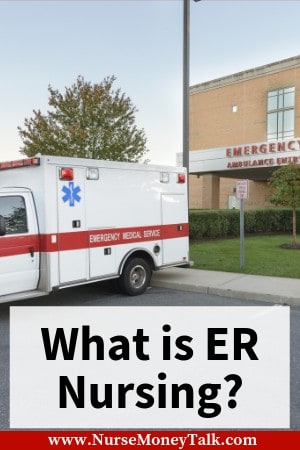While none of us want to find ourselves in the emergency room, you might have thought about what it’s like to work in one.
Here’s a look at what an ER nurse does and what kinds of education and qualifications you need to become one.
So, what is ER nursing? Emergency room nursing involves nurses taking care of patients who come to an ER for a medical emergency. ER nurses see a variety of patients ranging from pediatric to geriatric, from severe illnesses to the not so severe.
What Does an ER Nurse Actually Do?
An emergency room nurse is there to help patients who are coming into the hospital’s ER department for any number of reasons.
It could be that they are experiencing heart attack symptoms, they’re suffering a traumatic injury, or they’re severely dehydrated.
It’s not uncommon to find patients who have drank an excessive amount of alcohol or who have complaints of severe abdominal pain.
Basically, anything goes in the emergency room.
On any given day, an emergency room nurse could see people of all ages and backgrounds who are experiencing life-threatening injuries or ailments.
Yes, there are individuals who come in complaining of bad headaches, but there are also patients who have been shot or involved in car accidents.
An ER nurse needs to rule out possible conditions and administer medications or insert IV fluids.
An ER Nurse’s Role and Responsibilities
One of the primary concerns of an emergency room nurse is triaging patients. This means that he or she needs to determine the severity of the patient’s symptoms to assess what level of care they need.
Someone with a fractured wrist will not be as high of a priority as someone who is experiencing shortness of breath and stroke symptoms.
Besides triaging the patients, the ER nurse needs to keep up with documentation.
When they have a free moment, they will go to the hospital unit’s computer and enter the pertinent information on each patient.
This might include their medical history, any medications they were administered in the ER, their symptoms, and chief complaints, as well as any tests or scans they have undergone.
These medical reports come in handy when discharging the individual and passing the torch to the next ER nurse when their shift is over.
A big part of this job is being able to think quickly and handle multiple cases at once.
Very rarely do patients trickle into the emergency department one by one.
Some days are busier than others, but there is always a need for ER nurses to be at the ready.
These medical professionals also need to have a thorough knowledge of medications, diseases, and conditions so that they can rule out any diagnoses and better alert the physician.
Where Do ER Nurses Work?
You might think that an ER nurse only works in the emergency department of a hospital, but they might also be qualified to work as a CFRN (Certified Flight Registered Nurse).
Besides working in emergency rooms, some ER nurses work as flight nurses on emergency medical flights that transport patients to hospitals and medical centers.
These nurses secure the patient in the aircraft, administer medications, and keep them stable for the duration of the flight.
ER nurses might also work in urgent care facilities or even onsite at certain locations, such as community events.
There is always an opportunity for ER nurses to get to work and help individuals experiencing fatal or dangerous symptoms.
How Can I Become an ER Nurse?
The first step to becoming an ER nurse is obtaining a nursing degree and passing the board exams to become a registered nurse.
While some RNs get hired directly into an emergency department, this is rare, and usually only happens if an ER department is short staffed.
The more typical route is for the RN to work in a different unit for a couple of years and truly develop their nursing skills.
They should work on how to prioritize patients, efficiently multitask, and carry out critical care procedures, such as resuscitation.
Many RNs opt for certain certifications, including CEN (Certified Emergency Nurse) (source).
This shows future employers that they know how to work under time pressures and with life-threatening conditions.
Of course, it’s not just education and credentials that matter.
Emergency room nurses need to be adaptable and able to keep their cool under pressure since each day brings a new unpredictable shift.
Related Article: Can a New Nurse Work in the ER?
A Day in the Life of an ER Nurse
Ever wondered what it’s really like to work in the ER? Here’s an example of a typical ER nurse’s shift.
First, they will get the report from the previous shift’s nurse.
He or she should have outlined what went on in the emergency room for the past 12 hours or so, and if there are any patients that are still being held in the unit.
An ER nurse is typically assigned to a specific zone or area of the emergency unit, so they might have a handful of patients that they need to keep an eye on.
At the start of the shift, the nurse will check the patients’ charts to get a better idea of what they’re there for and what’s next for their treatment.
Once all of that initial research is done, the ER nurse will make their rounds to see each patient briefly.
This is their time to see what kind of shape they’re in and if they require a change of linens or other supplies.
Throughout the day – whenever they have time – the nurse will document each patient’s medical history, medication information, and other details in the computer system.
The day is also spent administering meds and IV fluids, as well as checking vitals.
Sometimes, patients will require further tests or scans, which can give the ER nurse a tiny break in the action, but for the most part, it’s about keeping the patients as comfortable as possible while quickly ruling out certain conditions and finding a diagnosis.
In any given day, an ER nurse could see dozens of patients, and each one will come in with their own set of problems.
It’s all about keeping up with the demand while accurately filling out patient reports, so the next nurse who comes in knows what to do.
Conclusion

Hopefully, you found this article helpful to define precisely what emergency room (ER) nursing is.
As stated above, it’s providing nursing care to patients coming into an emergency room.
Every day is different, and you might not know who’s coming in the door, it could be a trauma patient or a patient with a sore thumb.
Let us know what your thoughts are below in the comments section.
If you’re looking for more articles on emergency nursing, check out some of these other articles.


How many years does it take to become ER nurse
You can become an ER nurse right after nursing school. Check out the linked article for more information.